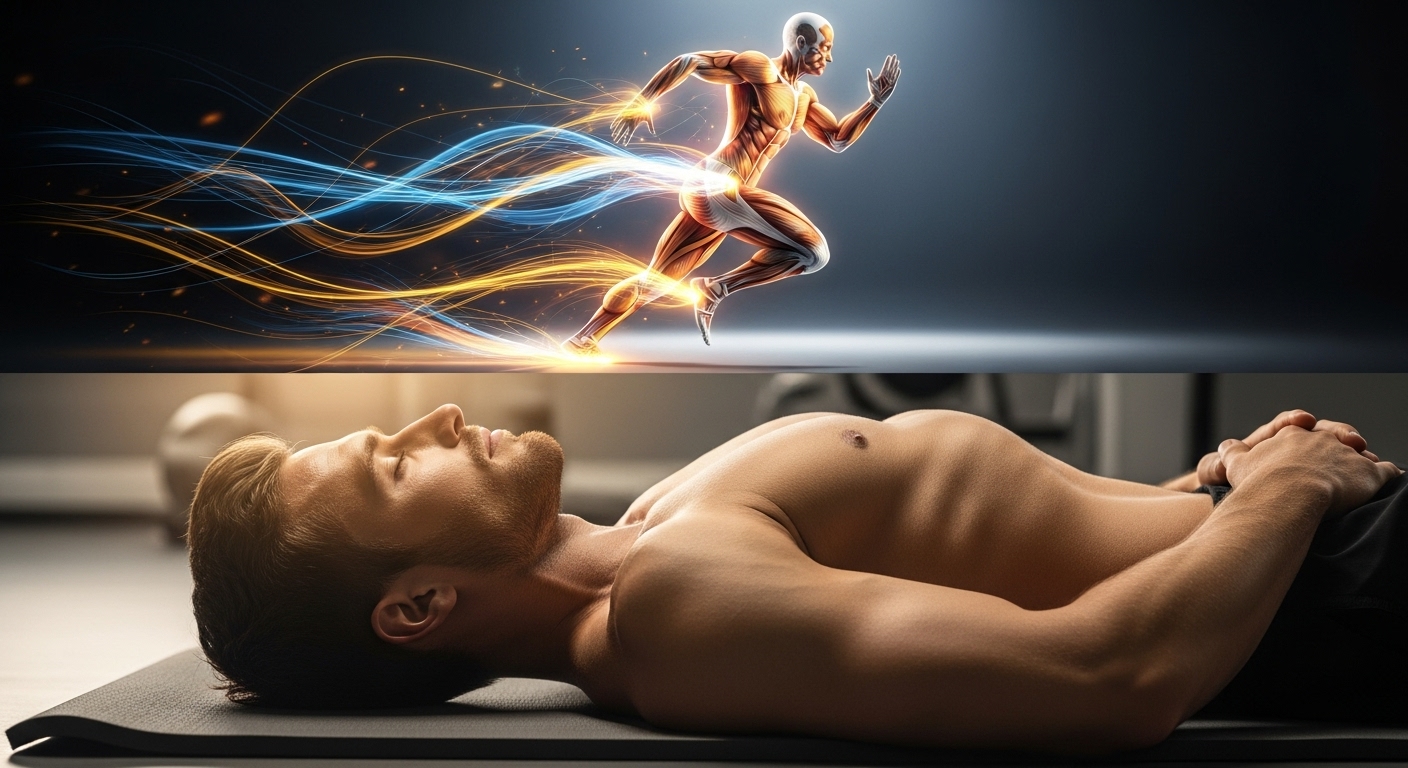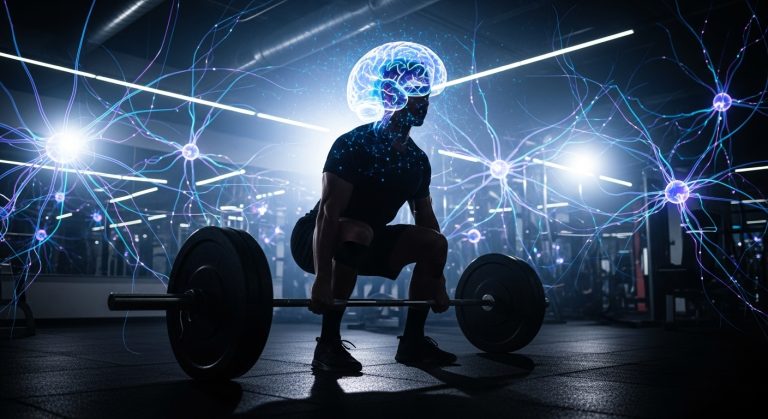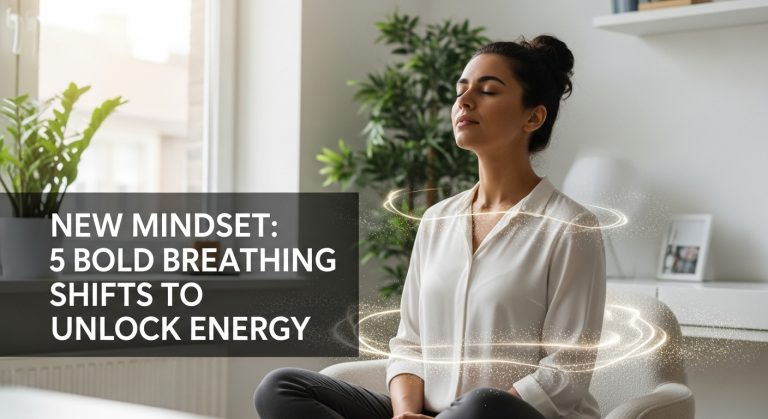Table of Contents
Introduction
The mind body connection is the most underutilized tool in recovery. Picture this: You’ve been recovering from an injury for weeks. Physical therapy is going well, your doctor says you’re healing on schedule, yet something still feels off. The mind body connection, that powerful bridge between your mental state and physical healing, might be the missing piece in your recovery puzzle.
You’re not alone. Thousands of people recovering from injuries, battling overtraining syndrome, or bouncing back from burnout discover that physical rest alone isn’t enough. Their bodies may be mending, but their minds remain stuck in patterns of stress and disconnection that actively slow healing. Understanding your mind body connection changes everything.
This is where guided imagery becomes your secret weapon. More than simple relaxation, guided imagery is a scientifically backed technique that leverages the mind body connection and your brain’s remarkable ability to influence physical processes. By engaging your imagination in specific, sensory rich ways, you can accelerate tissue repair, reduce pain, boost immune function, and reclaim mental resilience.
In this guide, you’ll discover seven powerful guided imagery protocols designed to strengthen your mind body connection for recovery, learn how to build a structured practice, and understand the neuroscience behind this approach.
Why Mind Body Connection Matters for Recovery ?

The mind & body connection isn’t mysticism, it’s a bidirectional highway of communication between your nervous system, immune system and every cell in your body. What you think and feel directly influences inflammation levels, hormone release, blood flow, and tissue repair.
Recent neuroscience research from Washington University reveals that the brain and body maintain continuous structural integration through complex neural networks. When you’re injured or fatigued, stress responses can hijack the mind & body connection, triggering inflammatory cascades that prolong recovery. Conversely, when you actively engage calming, healing mental imagery, you activate parasympathetic pathways that support cellular repair through the mind& body connection.
This is especially crucial during recovery from injury, training fatigue, or illness. Your stress response doesn’t distinguish between a charging tiger and worry about re-injury, both trigger cortisol release that suppresses immune function. The field of psychoneuroimmunology has documented clear links between chronic stress and compromised immunity, demonstrating that mental states are integral to the mind body connection.
When you strengthen your connection through guided imagery, you’re reprogramming the control center that governs your recovery. You’re teaching your nervous system to shift from survival mode to healing mode, allowing your body’s natural repair mechanisms to function optimally.
What Is Guided Imagery & How It Activates Mind Body Pathways ?
Guided imagery is the deliberate use of sensory rich mental imagery to evoke specific physical and emotional responses through the mind body connection. Unlike passive daydreaming, it’s a structured practice where you actively engage all your senses, sight, sound, touch, smell, and taste, to create vivid internal experiences that your brain processes as real.
Here’s the fascinating part: Your brain doesn’t fully distinguish between vividly imagined experiences and actual physical experiences. This is the mind body connection at work. When you imagine warmth flowing into an injured muscle, thermographic studies show actual temperature increases in that area. When you visualize your immune cells neutralizing threats, measurable changes occur in immune markers.
The theoretical foundation lies in perception theory and cross modal adaptation. Your brain integrates sensory information across multiple channels, and imagination activates many of the same neural pathways as direct experience through the mind body connection. This creates measurable physiological changes, heart rate variability shifts, muscle tension decreases, stress hormones drop, and healing promoting biochemicals increase.
Research published in PMC demonstrates that guided imagery produces significant stress reduction, enhanced attentional control, and direct physiological changes including improved immune function, reduced pain perception, and accelerated wound healing. These are quantifiable biological responses to the connection in action.
How to Lower Cortisol Naturally: 9 Life Changing Habits for Lasting Calm.
7 Guided Imagery Protocols to Accelerate Recovery.
Imagery for Pain Relief & Tissue Healing.
Pain is a complex neurological experience that can be modulated through the mind body connection and focused mental imagery. This protocol works by engaging neuromodulation pathways and influencing inflammation at the injury site.
Why it works: When you imagine healing sensations warmth, tingling, gentle pulsing your mind & body connection activates as your brain releases endorphins and activates descending pain inhibition pathways. You redirect attention away from pain catastrophizing, breaking the fear tension pain cycle.
Visualization steps:
- Find a comfortable position and close your eyes
- Bring attention to your injured area without judgment
- Imagine a healing light gently surrounding the area
- Visualize this light as warm, penetrating deep into tissues through your mind-body connection
- See the light carrying healing energy, oxygen, and nutrients to damaged cells
- Imagine inflammation melting away
- Sense tissues knitting back together, stronger and more resilient
- Hold this imagery for 10-15 minutes
Best timing: Practice immediately after physical therapy or before sleep when the body enters its deepest repair states and the mind & body connection is most receptive.
Imagery to Boost Circulation & Blood Flow.
Enhanced blood flow delivers oxygen and nutrients essential for tissue repair. The mind & body connection makes it possible to influence circulation through mental imagery alone.
Why it works: Mental imagery of warmth and fluid movement triggers vasodilation actual widening of blood vessels increasing circulation to targeted areas through the mind & body connection.
How to practice:
- Settle into stillness, tuning into your mind body connection.
- Imagine your bloodstream as a network of rivers carrying vital resources.
- Visualize warm, crimson blood flowing abundantly to your recovering area.
- See these rivers widening, the flow becoming stronger.
- Feel warmth spreading, oxygenation increasing through your mind & body connection.
- Imagine stagnation clearing, fresh vitality arriving with each heartbeat.
- Practice for 10-15 minutes daily.
Immune System Support Imagery.
Your immune system responds directly to mental imagery through the mind-body connection, making this protocol valuable for anyone recovering from illness or fighting infection alongside injury.
Why it works: Imagery of immune activity has been shown to increase natural killer cell activity and improve immune markers, demonstrating the power of the mind body connection.
Visualization process:
- Imagine your immune cells as a powerful healing army, activated through your mind-body connection
- Visualize white blood cells moving purposefully through your bloodstream
- See them arriving at areas needing healing, working efficiently
- Imagine them as bright, strong, intelligent protectors
- Visualize pathogens or damaged cells being gently neutralized
- See your immune system coordinating perfectly through the mind-body connection
- Feel trust in your body’s wisdom
Frequency: Practice 2-3 times daily for 10 minutes. Layer with adequate rest, your mind-body connection and immune system do their best work during sleep.
Stress Release & Autonomic Reset Imagery.
Chronic stress keeps your nervous system in sympathetic overdrive, disrupting the mind-body connection and suppressing healing. This protocol activates your parasympathetic system, restoring healthy mind-body connection function.
Why it works: Imagery of safety and release triggers vagal nerve activation through the mind-body connection, shifting your autonomic balance from fight or flight to rest and repair mode.
Steps:
- Visualize a completely safe, peaceful environment
- Engage all senses to strengthen your mind-body connection
- Imagine tension as dark smoke or heavy weights
- See this tension melting, dissolving, flowing out through your mind-body connection
- Feel muscles softening, jaw unclenching
- Imagine your entire nervous system resetting to calm baseline
- Spend 15-20 minutes in this state
Pro tip: Pair with 4-7-8 breathing to deepen the autonomic shift and enhance your mind-body connection.
Performance Recovery Imagery.
For athletes and active individuals, mentally rehearsing movement patterns during recovery maintains neural pathways through the mind-body connection and prepares for return to activity.
Why it works: Motor imagery activates similar brain regions as physical movement through the mind-body connection, preserving strength and coordination during forced rest.

Practice method:
- Visualize yourself performing your sport with perfect form engaging your mind-body connection.
- Imagine every detail equipment weight, surface beneath you, body position.
- See yourself moving powerfully, efficiently, pain free.
- Feel strength in recovered tissues, joints moving smoothly.
- Rehearse specific skills you want to maintain.
- Practice 10-15 minutes, 4-5 times weekly.
Sleep Deepening Imagery.
Quality sleep is when your body performs most tissue repair, making sleep optimization critical for recovery and a healthy mind body connection.
Why it works: Sleep imagery activates neural patterns associated with sleep onset through the mind-body connection, increasing slow wave sleep where growth hormone release and cellular repair peak.

Visualization for bedtime:
- Lie comfortably in bed, preparing your mind-body connection for rest.
- Imagine yourself at the top of a gentle staircase.
- With each breath, descend one step deeper into relaxation.
- Feel yourself becoming heavier, sinking into the bed.
- Visualize darkness or soft colors deepening with each step.
- Imagine your consciousness gently releasing its grip.
- Continue until you drift naturally into sleep.
Timing: Practice nightly as part of your sleep routine to support your connection.
Mental Resilience & Barrier Breach Imagery.
Recovery plateaus often reflect mental barriers more than physical limitations. This protocol builds psychological strength through the mind-body connection and breakthrough capacity.
Why it works: Imagery of overcoming obstacles strengthens prefrontal cortex circuits associated with persistence and self efficacy through the mind body connection.
Practice:
- Visualize a symbolic barrier representing your recovery obstacle.
- See yourself approaching with confidence, trusting your mind body connection.
- Imagine discovering or creating a way through.
- Feel the sensations of breakthrough flowing through your mind body connection.
- See yourself on the other side, transformed and stronger.
- Anchor this feeling in your body.
- Practice 10 minutes when facing discouragement.
Building a 4-8 Week Guided Imagery Recovery Plan.
Structured practice yields exponentially better results than sporadic sessions. Here’s how to periodize your imagery practice to maximize your mind body connection benefits.
Foundation Phase (Weeks 1-2): Focus on stress release and establishing the imagery habit while building your mind body connection awareness. Practice 10 to 15 minutes daily, primarily using the Stress Release protocol. Add Sleep Deepening imagery nightly. Goal: normalize parasympathetic dominance and strengthen your baseline mind body connection.
Build Phase (Weeks 3-5): Introduce recovery specific protocols to deepen your mind body connection. Practice 15-20 minutes twice daily, alternating between Pain Relief, Circulation Boost, and Immune Support imagery. Continue Sleep Deepening nightly. Your mind body connection becomes more responsive during this phase.
Maintenance Phase (Weeks 6-8): Integrate all protocols strategically to maintain optimal mind body connection function. Morning: Performance Recovery or Circulation. Afternoon: Pain Relief or Immune Support. Evening: Stress Release plus Sleep Deepening at bedtime.
Combining with other recovery modalities: Coordinate imagery with physical therapy practice circulation imagery before PT to prime your mind body connection, pain relief after. Layer with nutrition, practice immune imagery after meals when nutrient absorption peaks and your mind-body connection is engaged. Integrate with sleep hygiene and support with gentle movement like yoga or tai chi to enhance connection.
Read more articles from “Mind Body Integration” category.
Common Mistakes & Myths in Guided Imagery.
Myth: “Imagery is just daydreaming” Reality: Guided imagery is structured mental practice that produces measurable physiological changes through the mind body connection. Research confirms its biological effects.
Mistake: Skipping sensory detail The power of imagery lies in multi sensory engagement that activates your mind body connection. Rich sensory detail activates more neural pathways, producing stronger physical responses.
Mistake: Practicing once and expecting miracles The mind body connection strengthens through repetition. Neuroplasticity requires consistent practice. Daily practice over weeks creates lasting structural changes in neural networks and a robust mind body connection.
Myth: Imagery can replace medical care Guided imagery enhances the mind body connection but is complementary, not alternative medicine. It doesn’t replace appropriate medical treatment, physical therapy, adequate rest, or proper nutrition.
Pitfall: Forcing images or judging yourself Imagery works best with gentle allowance. Your mind body connection responds to relaxation, not tension. Self judgment and frustration trigger stress responses that counteract the practice’s benefits and disrupt your mind body connection.
Case Story: From Plateau to Breakthrough.

Marcus, a 34 year old distance runner, spent four months recovering from a severe hamstring tear. At 75% recovery, he hit a frustrating plateau. Pain persisted, range of motion stalled, and fear of re-injury crept into every movement. His mind body connection had become dominated by fear rather than healing.
His physiotherapist suggested incorporating guided imagery to restore his mind body connection. Marcus committed to the full protocol. He began with twice daily Stress Release sessions. Within a week, his nervous system settled, sleep improved, baseline tension decreased, and his mind body connection began to normalize.
He then added the Tissue Healing protocol, spending 15 minutes each morning visualizing his hamstring fibers realigning through his mind body connection. He imagined warm, healing blood flow during his afternoon sessions.
The turning point came in week three when he incorporated Performance Recovery imagery. Despite not yet running, he spent 10 minutes daily visualizing perfect running form. This mental rehearsal maintained neural pathways through his mind body connection and rebuilt confidence.
After six weeks of combined physical therapy and guided imagery practice, Marcus achieved full recovery. He emerged with a transformed understanding of his mind body connection. Running became an integrated experience where mental state and physical performance worked in harmony through a strong mind body connection.
How to Apply It in Different Contexts.
Athletes & Fitness Enthusiasts: Athletes benefit enormously from Performance Recovery and Tissue Healing imagery that strengthens the mind body connection. Integrate imagery into existing routines, practice circulation boost during ice baths, use pain relief imagery during massage to enhance your mind body connection.
Professionals & Desk Bound Workers: Chronic muscle tension, repetitive stress injuries, and burnout respond exceptionally well to guided imagery and mind body connection restoration. Focus on Stress Release and Circulation Boost protocols during workday breaks. Even five minutes of imagery between meetings can reset your autonomic nervous system.
Chronic Conditions & Long Term Wellness: For those managing ongoing health challenges, guided imagery offers sustainable self care that complements medical treatment by supporting the mind body connection. Immune Support imagery benefits anyone with inflammatory conditions, while Mental Resilience protocols help navigate emotional challenges of long term recovery.
Your Recovery Journey Begins Now.
The connection you’ve been strengthening throughout this article isn’t theoretical, it’s the very mechanism through which you’ll accelerate your recovery. Every moment you spend in focused imagery is an investment in your body’s healing capacity and your mind body connection.
Start simple: choose one protocol that resonates most with your current recovery needs and begin building your mind body connection. Practice for just 10 minutes daily for one week. Notice what shifts pain levels, sleep quality, mood, energy all indicators of your strengthening mind body connection. Build from there, gradually incorporating additional protocols as your practice deepens.
Remember, guided imagery isn’t about perfection or forcing specific outcomes. It’s about creating optimal conditions for your mind body connection to function at its best, allowing your body’s innate wisdom to heal, recover, and emerge stronger. Your imagination is one of the most powerful healing tools you possess, directly accessing your mind body connection. It’s time to put it to work.
TOP 15 FAQ
-
How do I activate my mind body connection?
Use guided imagery: imagine healing light, warmth, or circulating blood focusing all senses. Practice daily for 10–15 minutes.
-
How to create a mind-body connection?
Build awareness through stress release imagery first, then layer in healing, circulation, immune, performance protocols over weeks.
-
What does the Bible say about the mind and body connection?
The Bible sees body, soul, and spirit as interconnected (holistic), e.g. 1 Corinthians 6:19 calls the body a temple of the Spirit.
-
What is the connection between mind and body called?
It’s commonly called the “mind-body connection” or psychoneuroimmunology (linking mind, nerve, and immune systems).
-
Mind-body connection book
Look for books on guided imagery, mind-body healing, or psychoneuroimmunology—titles that teach structured mental imagery methods.
-
Mind body connection psychology
It studies how mental states influence physical processes (immune, inflammation, healing) via neural and endocrine pathways.
-
Mind-body connection anxiety
Guided imagery can downregulate stress circuits, reduce cortisol, and ease anxiety via activating parasympathetic healing states.
-
Mind-body connection examples
Visualizing healing light on a wound, imagining blood flow to a muscle, or rehearsing movement mentally are examples.
-
Mind body connection meaning
It means your thoughts, emotions, and mental imagery directly influence your body’s physiology and healing.
-
Mind-body connection research
Studies show brain-body networks are structurally integrated, and mind interventions alter immune, inflammation, pain markers.
-
Mind-body connection exercise
Guided imagery protocols, mindful movement (yoga, tai chi), and breathwork help strengthen the connection.
-
Can guided imagery really heal tissue?
Yes, when vivid, guided imagery can stimulate tissue repair, reduce inflammation, and boost circulation.
-
How soon do results appear?
You may sense reduced stress or pain in days; tissue-level changes typically emerge over weeks with consistent practice.
-
How long should I practice daily?
Start with 10–15 minutes once or twice daily; increase to 15–20 minutes as your practice deepens.
-
Can imagery replace medical therapy?
No, imagery complements physical therapy, rest, nutrition, but does not replace medical or professional care.






